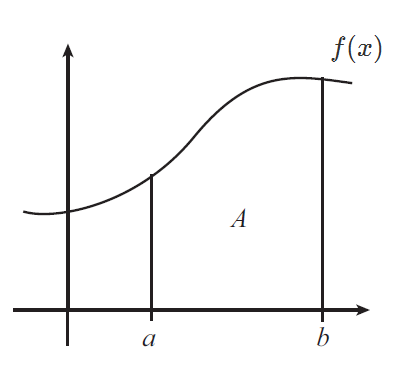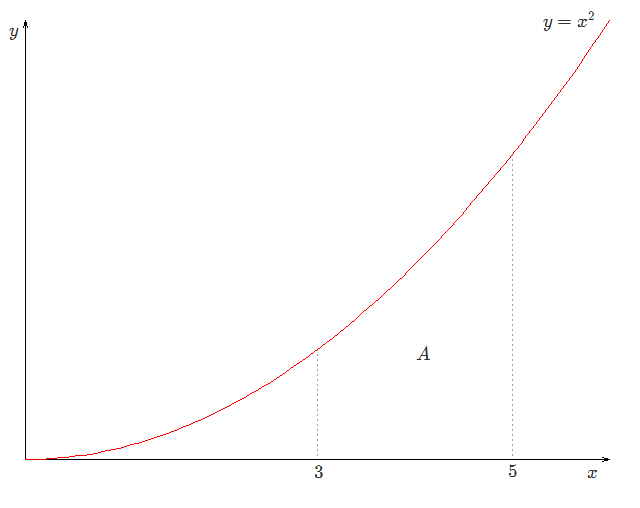Definite Integration
Definition and Notation
The definite integral
\[\int_{\large{a} }^{\large{b} }\,f(x)\, \mathrm{d}x\]
is an integral to be evaluated between a lower limit $a$ and upper limit $b$.
By the fundamental theorem of calculus, if $F(x)$ is the antiderivative of $f(x)$, then
\[\int_{\large{a} }^{\large{b} }\,f(x)\, \mathrm{d}x=F(b)-F(a).\]
When computing a definite integral, it is conventional to use square brackets in the following way to denote that the antiderivative $F(x)$ is to be evaluated between limits $a$ and $b$.
\[\int_{\large{a} }^{\large{b} }\,f(x)\, \mathrm{d}x=\Bigl[F(x)\Bigl]_{\large{a} }^{\large{b} }=F(b)-F(a).\]
Constant of Integration
When evaluting definite integrals it is not necessary to include the constant of integration, $C$, that arises in indefinite integration.
Given a function $f(x)$ with indefinite integral $\begin{align}\int f(x)\;\mathrm{d}x=F(x)+C\end{align}$, the definite integral of this function between limits $a$ and $b$ is:
\begin{align} \int_{\large{a} }^{\large{b} } f(x)\;\mathrm{d}x &= \Bigl[F(x)+C\Bigl]_{\large{a} }^{\large{b} } \\ &= \left\{F(b)+C\right\}-\left\{F(a)+C\right\} \\ &= F(b)-F(a)+C-C \\ &= F(b)-F(a). \end{align}
Note that the constant of integration $C$ cancels out. Since this is the case for any definite integral, it is typically not included in calculations.
Properties
- Since integration is a linear operation, the following property holds:
\[\int_{\large{a} }^{\large{b} } \Bigl(\alpha f(x) + \beta g(x)\Bigl) \; \mathrm{d} x = \alpha\int_{\large{a} }^{\large{b} } f(x) \; \mathrm{d} x +\beta \int_{\large{a} }^{\large{b} } g(x) \; \mathrm{d} x,\]
when $\alpha$ and $\beta$ are constants.
This means that integrals can be split up into their separate terms, and that constant factors can be taken outside of the integral.
- Swapping the limits of the integral swaps the sign of the result:
\[\int_{\large{a} }^{\large{b} }f(x)\;\mathrm{d}x=-\int_{\large{b} }^{\large{a} }f(x)\;\mathrm{d}x.\]
- Suppose that $a\leq c\leq b$. Then the following property holds:
\[\int_{\large{a} }^{\large{b} }f(x)\;\mathrm{d}x=\int_{\large{a} }^{\large{c} } f(x)\;\mathrm{d}x+\int_{\large{c} }^{\large{b} }f(x)\;\mathrm{d}x.\]
Integral as the Area under a Curve
Consider a curve $y=f(x)$ such that $f(x)$ lies above the x-axis between $a$ and $b$. Then the area $A$ under the curve between $a$ and $b$ is given by
\[A = \int_a^b \, f(x) \mathrm{d} x .\]
The following graph shows the area $A$ under the curve $y=f(x)$ between the lines $x=a$ and $x=b$, which is represented by the above integral.

|250px
Worked Example
Example 1
Find the area, $A$, under the curve $y=x^2$ between $x=3$ and $x=5$.
Solution
The area $A$ is given by the integral
\[A=\int_3^5 \, x^2 \, \mathrm{d}x.\]
To evaluate this integral recall that the indefinite integral, or antiderivative, of $x^2$ is $\dfrac{x^3}{3}$.
Hence the area $A$ is:
\begin{align} A &=\int_3^5 \, x^2 \, \mathrm{d}x = \left[ \dfrac{x^3}{3} \right]_3^5 \\ &=\dfrac{5^3}{3}-\dfrac{3^3}{3} \\ &=\dfrac{125}{3}-\dfrac{27}{3} \\ &=\dfrac{98}{3}. \end{align}

|250px
Video Examples
Example 1
Prof. Robin Johnson computes $\begin{align}\int_{-1}^1 x^2 \; \mathrm{d}x\end{align}$, $\begin{align}\int_0^\pi \left(\mathrm{e}^{-t}+\sin{(2t)}\right)\;\mathrm{d}t\end{align}$ and $\begin{align}\int_1^\infty \dfrac{2}{x^3} \; \mathrm{d}x\end{align}$.
Example 2
Prof. Robin Johnson finds the area under the curve $y=\mathrm{e}^{2\large{x} }+x^2$ between $x=0$ and $x=1$.
Example 3
Prof. Robin Johnson finds the area bounded between the curves $y=2x-x^2$ and $y=\dfrac{1}{3}x^2$.
Workbooks
These workbooks produced by HELM are good revision aids, containing key points for revision and many worked examples.
Test Yourself
External Resources
- Table of integrals at mathcentre.
- Evaluating definite integrals workbook at mathcentre.
- Finding areas by integration workbook at mathcentre.
- Finding volumes of solids of rotation by integration workbook at mathcentre.
- Definite integrals videos at Khan Academy.